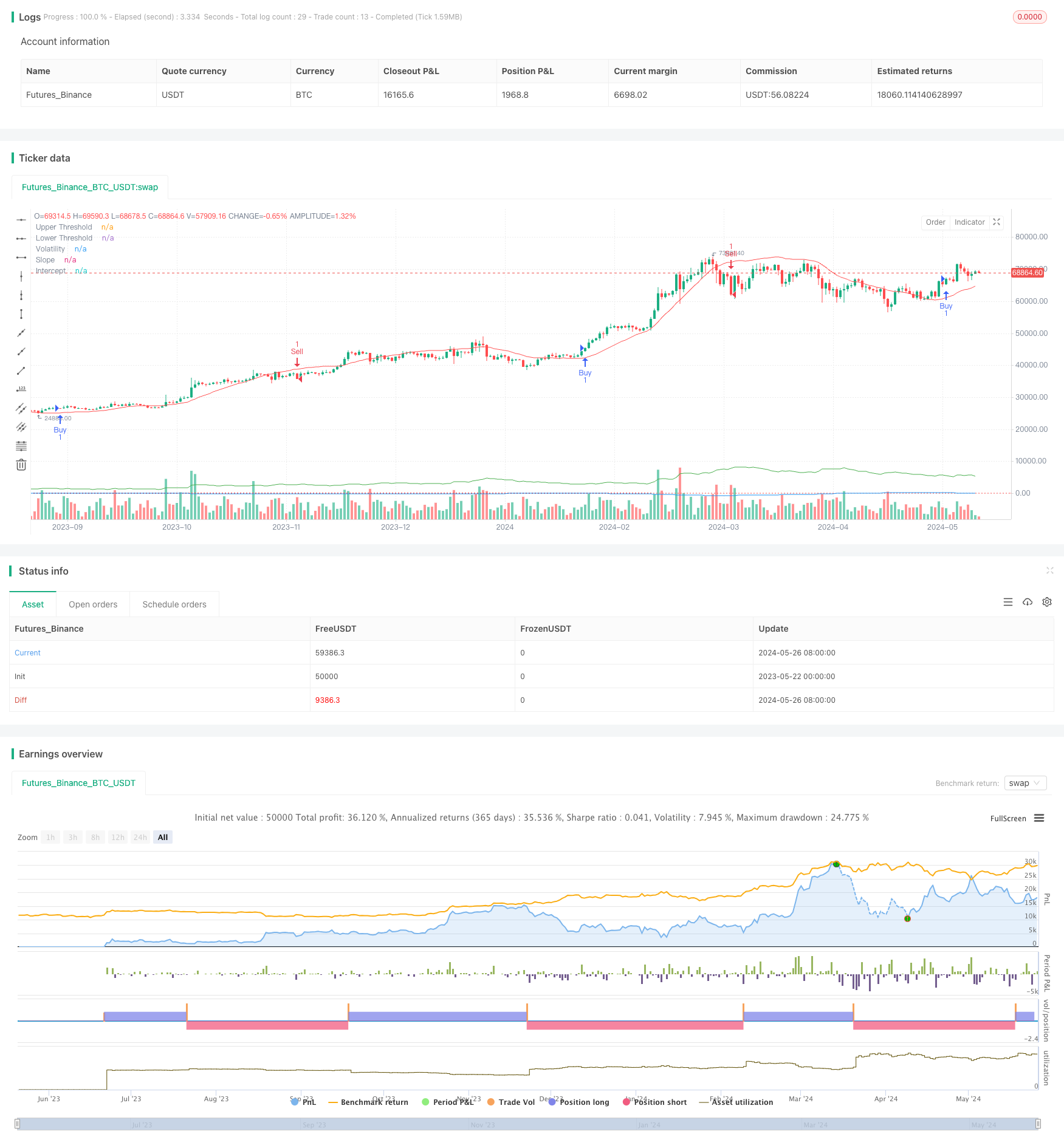
概述
该策略利用线性回归和波动率指标来识别不同的市场状态,当满足买入或卖出条件时,策略会建立相应的多头或空头仓位。同时,该策略允许根据市场状况进行参数优化和调整,以适应不同的市场环境。策略还使用指数移动平均线作为附加指标来确认交易信号。
策略原理
- 计算线性回归的截距和斜率,用于确定市场趋势。
- 计算平均真实波动率(ATR)乘以乘数作为波动率指标。
- 当斜率大于上阈值且价格高于回归线加上波动率时,产生买入信号。
- 当斜率小于下阈值且价格低于回归线减去波动率时,产生卖出信号。
- 使用快速和慢速指数移动平均线(EMA)作为附加确认指标。
- 当买入信号出现且快速EMA高于慢速EMA时,建立多头仓位。
- 当卖出信号出现且快速EMA低于慢速EMA时,建立空头仓位。
策略优势
- 结合线性回归和波动率指标,可以更准确地识别市场状态和趋势。
- 使用附加的EMA指标来确认交易信号,提高策略的可靠性。
- 允许对关键参数进行优化,以适应不同的市场环境和品种特性。
- 同时考虑趋势和波动性,可以在趋势明确时及时建仓,在波动加剧时控制风险。
策略风险
- 参数选择不当可能导致策略表现不佳,需要根据具体品种和市场特点进行优化。
- 在震荡市场或趋势转折点,策略可能会出现频繁交易或错误信号。
- 策略依赖于历史数据,对于突发事件或市场异常波动可能反应不及时。
策略优化方向
- 引入其他技术指标或基本面因素,丰富策略的决策依据,提高信号准确性。
- 优化参数选择,如回归长度、波动率乘数、EMA周期等,以适应不同品种和市场特点。
- 增加止损和止盈机制,控制单笔交易风险和总体回撤水平。
- 考虑加入仓位管理和资金管理规则,根据市场波动和账户equity调整仓位大小。
总结
该策略通过线性回归和波动率指标识别市场状态,并使用EMA作为确认指标,构建了一个适应性强、逻辑清晰的交易策略。策略的优势在于结合趋势和波动性,同时允许参数优化,适用于不同市场环境。但策略也存在参数选择、震荡市和黑天鹅事件等风险,需要在实际应用中不断优化和完善。未来可以从丰富信号来源、优化参数选择、完善风控措施等方面对策略进行改进,以提升其稳定性和盈利能力。
策略源码
/*backtest
start: 2023-05-22 00:00:00
end: 2024-05-27 00:00:00
period: 1d
basePeriod: 1h
exchanges: [{"eid":"Futures_Binance","currency":"BTC_USDT"}]
*/
// This Pine Script™ code is subject to the terms of the Mozilla Public License 2.0 at https://mozilla.org/MPL/2.0/
// © tmalvao
//@version=5
strategy("Regime de Mercado com Regressão e Volatilidade Otimizado", overlay=true)
// Parâmetros para otimização
upperThreshold = input.float(1.0, title="Upper Threshold")
lowerThreshold = input.float(-1.0, title="Lower Threshold")
length = input.int(50, title="Length", minval=1)
// Indicadores de volatilidade
atrLength = input.int(14, title="ATR Length")
atrMult = input.float(2.0, title="ATR Multiplier")
atr = ta.atr(atrLength)
volatility = atr * atrMult
// Calculando a regressão linear usando função incorporada
intercept = ta.linreg(close, length, 0)
slope = ta.linreg(close, length, 1) - ta.linreg(close, length, 0)
// Sinal de compra e venda
buySignal = slope > upperThreshold and close > intercept + volatility
sellSignal = slope < lowerThreshold and close < intercept - volatility
// Entrando e saindo das posições
if (buySignal)
strategy.entry("Buy", strategy.long)
if (sellSignal)
strategy.entry("Sell", strategy.short)
// Indicadores adicionais para confirmação
emaFastLength = input.int(10, title="EMA Fast Length")
emaSlowLength = input.int(50, title="EMA Slow Length")
emaFast = ta.ema(close, emaFastLength)
emaSlow = ta.ema(close, emaSlowLength)
// Confirmando sinais com EMAs
if (buySignal and emaFast > emaSlow)
strategy.entry("Buy Confirmed", strategy.long)
if (sellSignal and emaFast < emaSlow)
strategy.entry("Sell Confirmed", strategy.short)
// Exibindo informações no gráfico
plot(slope, title="Slope", color=color.blue)
plot(intercept, title="Intercept", color=color.red)
plot(volatility, title="Volatility", color=color.green)
hline(upperThreshold, "Upper Threshold", color=color.green, linestyle=hline.style_dotted)
hline(lowerThreshold, "Lower Threshold", color=color.red, linestyle=hline.style_dotted)
相关推荐